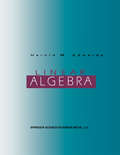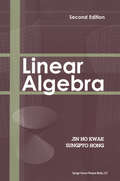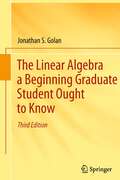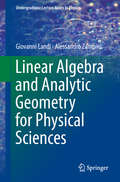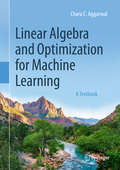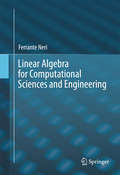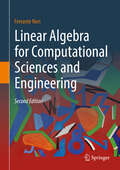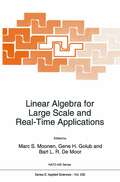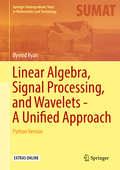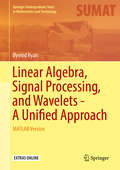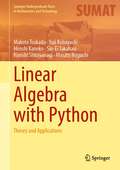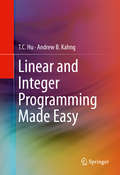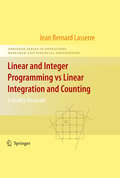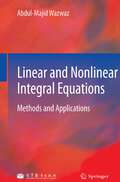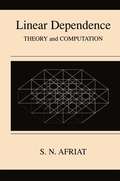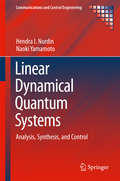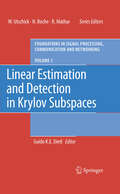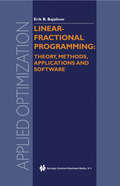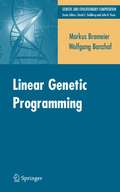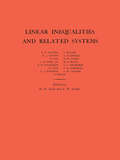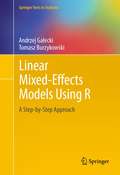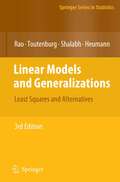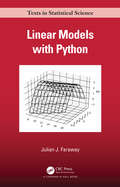- Table View
- List View
Linear Algebra
by Harold M. Edwards* Proposes a radically new and thoroughly algorithmic approach to linear algebra * Each proof is an algorithm described in English that can be translated into the computer language the class is using and put to work solving problems and generating new examples* Designed for a one-semester course, this text gives the student many examples to work through and copious exercises to test their skills and extend their knowledge of the subject
Linear Algebra
by Jin Ho Kwak Sungpyo HongPresents the basic concepts of linear algebra as a coherent part of mathematics. This new edition includes substantial revisions, new material on minimal polynomials and diagonalization, as well as a variety of new applications. Rich selection of examples and explanations, as well as a wide range of exercises at the end of every section.
The Linear Algebra a Beginning Graduate Student Ought to Know
by Jonathan S. GolanThis book rigorously deals with the abstract theory and, at the same time, devotes considerable space to the numerical and computational aspects of linear algebra. It features a large number of thumbnail portraits of researchers who have contributed to the development of linear algebra as we know it today and also includes over 1,000 exercises, many of which are very challenging. The book can be used as a self-study guide; a textbook for a course in advanced linear algebra, either at the upper-class undergraduate level or at the first-year graduate level; or as a reference book.
The Linear Algebra a Beginning Graduate Student Ought to Know
by Jonathan S. GolanLinear algebra is a living, active branch of mathematics which is central to almost all other areas of mathematics, both pure and applied, as well as to computer science, to the physical, biological, and social sciences, and to engineering. It encompasses an extensive corpus of theoretical results as well as a large and rapidly-growing body of computational techniques. Unfortunately, in the past decade, the content of linear algebra courses required to complete an undergraduate degree in mathematics has been depleted to the extent that they fail to provide a sufficient theoretical or computational background. Students are not only less able to formulate or even follow mathematical proofs, they are also less able to understand the mathematics of the numerical algorithms they need for applications. Certainly, the material presented in the average undergraduate course is insufficient for graduate study. This book is intended to fill the gap which has developed by providing enough theoretical and computational material to allow the advanced undergraduate or beginning graduate student to overcome this deficiency and be able to work independently or in advanced courses. The book is intended to be used either as a self-study guide, a textbook for a course in advanced linear algebra, or as a reference book. It is also designed to prepare a student for the linear algebra portion of prelim exams or PhD qualifying exams. The volume is self-contained to the extent that it does not assume any previous formal knowledge of linear algebra, though the reader is assumed to have been exposed, at least informally, to some of the basic ideas and techniques, such as manipulation of small matrices and the solution of small systems of linear equations over the real numbers. More importantly, it assumes a seriousness of purpose, considerable motivation, and a modicum of mathematical sophistication on the part of the reader. In the latest edition, new major theorems have been added, as well as many new examples. There are over 130 additional exercises and many of the previous exercises have been revised or rewritten. In addition, a large number of additional biographical notes and thumbnail portraits of mathematicians have been included.
Linear Algebra and Analytic Geometry for Physical Sciences (Undergraduate Lecture Notes in Physics)
by Giovanni Landi Alessandro ZampiniA self-contained introduction to finite dimensional vector spaces, matrices, systems of linear equations, spectral analysis on euclidean and hermitian spaces, affine euclidean geometry, quadratic forms and conic sections. The mathematical formalism is motivated and introduced by problems from physics, notably mechanics (including celestial) and electro-magnetism, with more than two hundreds examples and solved exercises.Topics include: The group of orthogonal transformations on euclidean spaces, in particular rotations, with Euler angles and angular velocity. The rigid body with its inertia matrix. The unitary group. Lie algebras and exponential map. The Dirac’s bra-ket formalism. Spectral theory for self-adjoint endomorphisms on euclidean and hermitian spaces. The Minkowski spacetime from special relativity and the Maxwell equations. Conic sections with the use of eccentricity and Keplerian motions. An appendix collects basic algebraic notions like group, ring and field; and complex numbers and integers modulo a prime number.The book will be useful to students taking a physics or engineer degree for a basic education as well as for students who wish to be competent in the subject and who may want to pursue a post-graduate qualification.
Linear Algebra and Optimization for Machine Learning: A Textbook
by Charu C. AggarwalThis textbook introduces linear algebra and optimization in the context of machine learning. Examples and exercises are provided throughout this text book together with access to a solution’s manual. This textbook targets graduate level students and professors in computer science, mathematics and data science. Advanced undergraduate students can also use this textbook. The chapters for this textbook are organized as follows:1. Linear algebra and its applications: The chapters focus on the basics of linear algebra together with their common applications to singular value decomposition, matrix factorization, similarity matrices (kernel methods), and graph analysis. Numerous machine learning applications have been used as examples, such as spectral clustering, kernel-based classification, and outlier detection. The tight integration of linear algebra methods with examples from machine learning differentiates this book from generic volumes on linear algebra. The focus is clearly on the most relevant aspects of linear algebra for machine learning and to teach readers how to apply these concepts.2. Optimization and its applications: Much of machine learning is posed as an optimization problem in which we try to maximize the accuracy of regression and classification models. The “parent problem” of optimization-centric machine learning is least-squares regression. Interestingly, this problem arises in both linear algebra and optimization, and is one of the key connecting problems of the two fields. Least-squares regression is also the starting point for support vector machines, logistic regression, and recommender systems. Furthermore, the methods for dimensionality reduction and matrix factorization also require the development of optimization methods. A general view of optimization in computational graphs is discussed together with its applications to back propagation in neural networks. A frequent challenge faced by beginners in machine learning is the extensive background required in linear algebra and optimization. One problem is that the existing linear algebra and optimization courses are not specific to machine learning; therefore, one would typically have to complete more course material than is necessary to pick up machine learning. Furthermore, certain types of ideas and tricks from optimization and linear algebra recur more frequently in machine learning than other application-centric settings. Therefore, there is significant value in developing a view of linear algebra and optimization that is better suited to the specific perspective of machine learning.
Linear Algebra for Computational Sciences and Engineering
by Ferrante NeriThis book presents the main concepts of linear algebra from the viewpoint of applied scientists such as computer scientists and engineers, without compromising on mathematical rigor. Based on the idea that computational scientists and engineers need, in both research and professional life, an understanding of theoretical concepts of mathematics in order to be able to propose research advances and innovative solutions, every concept is thoroughly introduced and is accompanied by its informal interpretation. Furthermore, most of the theorems included are first rigorously proved and then shown in practice by a numerical example. When appropriate, topics are presented also by means of pseudocodes, thus highlighting the computer implementation of algebraic theory.It is structured to be accessible to everybody, from students of pure mathematics who are approaching algebra for the first time to researchers and graduate students in applied sciences who need a theoretical manual of algebra to successfully perform their research. Most importantly, this book is designed to be ideal for both theoretical and practical minds and to offer to both alternative and complementary perspectives to study and understand linear algebra.
Linear Algebra for Computational Sciences and Engineering
by Ferrante NeriThis book presents the main concepts of linear algebra from the viewpoint of applied scientists such as computer scientists and engineers, without compromising on mathematical rigor. Based on the idea that computational scientists and engineers need, in both research and professional life, an understanding of theoretical concepts of mathematics in order to be able to propose research advances and innovative solutions, every concept is thoroughly introduced and is accompanied by its informal interpretation. Furthermore, most of the theorems included are first rigorously proved and then shown in practice by a numerical example. When appropriate, topics are presented also by means of pseudocodes, thus highlighting the computer implementation of algebraic theory.It is structured to be accessible to everybody, from students of pure mathematics who are approaching algebra for the first time to researchers and graduate students in applied sciences who need a theoretical manual of algebra to successfully perform their research. Most importantly, this book is designed to be ideal for both theoretical and practical minds and to offer to both alternative and complementary perspectives to study and understand linear algebra.
Linear Algebra for Large Scale and Real-Time Applications (NATO Science Series E: #232)
by M. S. Moonen Gene H. Golub B. L. De MoorProceedings of the NATO Advanced Study Institute, Leuven, Belgium, August 3-14, 1992
Linear Algebra, Signal Processing, and Wavelets - A Unified Approach: Python Version (Springer Undergraduate Texts in Mathematics and Technology)
by Øyvind RyanThis book offers a user friendly, hands-on, and systematic introduction to applied and computational harmonic analysis: to Fourier analysis, signal processing and wavelets; and to their interplay and applications. The approach is novel, and the book can be used in undergraduate courses, for example, following a first course in linear algebra, but is also suitable for use in graduate level courses. The book will benefit anyone with a basic background in linear algebra. It defines fundamental concepts in signal processing and wavelet theory, assuming only a familiarity with elementary linear algebra. No background in signal processing is needed. Additionally, the book demonstrates in detail why linear algebra is often the best way to go. Those with only a signal processing background are also introduced to the world of linear algebra, although a full course is recommended.The book comes in two versions: one based on MATLAB, and one on Python, demonstrating the feasibility and applications of both approaches. Most of the code is available interactively. The applications mainly involve sound and images. The book also includes a rich set of exercises, many of which are of a computational nature.
Linear Algebra, Signal Processing, and Wavelets - A Unified Approach: MATLAB Version (Springer Undergraduate Texts in Mathematics and Technology)
by Øyvind RyanThis book offers a user friendly, hands-on, and systematic introduction to applied and computational harmonic analysis: to Fourier analysis, signal processing and wavelets; and to their interplay and applications. The approach is novel, and the book can be used in undergraduate courses, for example, following a first course in linear algebra, but is also suitable for use in graduate level courses. The book will benefit anyone with a basic background in linear algebra. It defines fundamental concepts in signal processing and wavelet theory, assuming only a familiarity with elementary linear algebra. No background in signal processing is needed. Additionally, the book demonstrates in detail why linear algebra is often the best way to go. Those with only a signal processing background are also introduced to the world of linear algebra, although a full course is recommended. The book comes in two versions: one based on MATLAB, and one on Python, demonstrating the feasibility and applications of both approaches. Most of the MATLAB code is available interactively. The applications mainly involve sound and images. The book also includes a rich set of exercises, many of which are of a computational nature.
Linear Algebra with Python: Theory and Applications (Springer Undergraduate Texts in Mathematics and Technology)
by Makoto Tsukada Yuji Kobayashi Hiroshi Kaneko Sin-Ei Takahasi Kiyoshi Shirayanagi Masato NoguchiThis textbook is for those who want to learn linear algebra from the basics. After a brief mathematical introduction, it provides the standard curriculum of linear algebra based on an abstract linear space. It covers, among other aspects: linear mappings and their matrix representations, basis, and dimension; matrix invariants, inner products, and norms; eigenvalues and eigenvectors; and Jordan normal forms. Detailed and self-contained proofs as well as descriptions are given for all theorems, formulas, and algorithms. A unified overview of linear structures is presented by developing linear algebra from the perspective of functional analysis. Advanced topics such as function space are taken up, along with Fourier analysis, the Perron–Frobenius theorem, linear differential equations, the state transition matrix and the generalized inverse matrix, singular value decomposition, tensor products, and linear regression models. These all provide a bridge to more specialized theories based on linear algebra in mathematics, physics, engineering, economics, and social sciences. Python is used throughout the book to explain linear algebra. Learning with Python interactively, readers will naturally become accustomed to Python coding. By using Python’s libraries NumPy, Matplotlib, VPython, and SymPy, readers can easily perform large-scale matrix calculations, visualization of calculation results, and symbolic computations. All the codes in this book can be executed on both Windows and macOS and also on Raspberry Pi.
Linear and Integer Programming Made Easy
by T. C. Hu Andrew B. KahngThis textbook provides concise coverage of the basics of linear and integer programming which, with megatrends toward optimization, machine learning, big data, etc., are becoming fundamental toolkits for data and information science and technology. The authors’ approach is accessible to students from almost all fields of engineering, including operations research, statistics, machine learning, control system design, scheduling, formal verification and computer vision. The presentations enables the basis for numerous approaches to solving hard combinatorial optimization problems through randomization and approximation. Readers will learn to cast various problems that may arise in their research as optimization problems, understand the cases where the optimization problem will be linear, choose appropriate solution methods and interpret results appropriately.
Linear and Integer Programming vs Linear Integration and Counting: A Duality Viewpoint (Springer Series in Operations Research and Financial Engineering #Vol. 34)
by Jean-Bernard LasserreLinear and Nonlinear Integral Equations: Methods and Applications
by Abdul-Majid WazwazLinear and Nonlinear Integral Equations: Methods and Applications is a self-contained book divided into two parts. Part I offers a comprehensive and systematic treatment of linear integral equations of the first and second kinds. The text brings together newly developed methods to reinforce and complement the existing procedures for solving linear integral equations. The Volterra integral and integro-differential equations, the Fredholm integral and integro-differential equations, the Volterra-Fredholm integral equations, singular and weakly singular integral equations, and systems of these equations, are handled in this part by using many different computational schemes. Selected worked-through examples and exercises will guide readers through the text. Part II provides an extensive exposition on the nonlinear integral equations and their varied applications, presenting in an accessible manner a systematic treatment of ill-posed Fredholm problems, bifurcation points, and singular points. Selected applications are also investigated by using the powerful Padé approximants. This book is intended for scholars and researchers in the fields of physics, applied mathematics and engineering. It can also be used as a text for advanced undergraduate and graduate students in applied mathematics, science and engineering, and related fields. Dr. Abdul-Majid Wazwaz is a Professor of Mathematics at Saint Xavier University in Chicago, Illinois, USA.
Linear Dependence: Theory and Computation
by Sydney N. AfriatDeals with the most basic notion of linear algebra, to bring emphasis on approaches to the topic serving at the elementary level and more broadly. A typical feature is where computational algorithms and theoretical proofs are brought together. Another is respect for symmetry, so that when this has some part in the form of a matter it should also be reflected in the treatment. Issues relating to computational method are covered. These interests may have suggested a limited account, to be rounded-out suitably. However this limitation where basic material is separated from further reaches of the subject has an appeal of its own. To the `elementary operations' method of the textbooks for doing linear algebra, Albert Tucker added a method with his `pivot operation'. Here there is a more primitive method based on the `linear dependence table', and yet another based on `rank reduction'. The determinant is introduced in a completely unusual upside-down fashion where Cramer's rule comes first. Also dealt with is what is believed to be a completely new idea, of the `alternant', a function associated with the affine space the way the determinant is with the linear space, with n+1 vector arguments, as the determinant has n. Then for affine (or barycentric) coordinates we find a rule which is an unprecedented exact counterpart of Cramer's rule for linear coordinates, where the alternant takes on the role of the determinant. These are among the more distinct or spectacular items for possible novelty, or unfamiliarity. Others, with or without some remark, may be found scattered in different places.
Linear Dynamical Quantum Systems: Analysis, Synthesis, and Control (Communications and Control Engineering)
by Hendra I Nurdin Naoki YamamotoThis monograph provides an in-depth treatment of the class of linear-dynamical quantum systems. The monograph presents a detailed account of the mathematical modeling of these systems using linear algebra and quantum stochastic calculus as the main tools for a treatment that emphasizes a system-theoretic point of view and the control-theoretic formulations of quantum versions of familiar problems from the classical (non-quantum) setting, including estimation and filtering, realization theory, and feedback control. Both measurement-based feedback control (i.e., feedback control by a classical system involving a continuous-time measurement process) and coherent feedback control (i.e., feedback control by another quantum system without the intervention of any measurements in the feedback loop) are treated. Researchers and graduates studying systems and control theory, quantum probability and stochastics or stochastic control whether from backgrounds in mechanical or electrical engineering or applied mathematics will find this book to be a valuable treatment of the control of an important class of quantum systems. The material presented here will also interest physicists working in optics, quantum optics, quantum information theory and other quantum-physical disciplines.
Linear Estimation and Detection in Krylov Subspaces (Foundations in Signal Processing, Communications and Networking #1)
by Guido K. DietlThis book focuses linear estimation theory, which is essential for effective signal processing. The first section offers a comprehensive overview of key methods like reduced-rank signal processing and Krylov subspace methods of numerical mathematics. Also, the relationship between statistical signal processing and numerical mathematics is presented. In the second part, the theory is applied to iterative multiuser detection receivers (Turbo equalization) which are typically desired in wireless communications systems.
Linear-Fractional Programming Theory, Methods, Applications and Software (Applied Optimization #84)
by E.B. BajalinovThis is a book on Linear-Fractional Programming (here and in what follows we will refer to it as "LFP"). The field of LFP, largely developed by Hungarian mathematician B. Martos and his associates in the 1960's, is concerned with problems of op timization. LFP problems deal with determining the best possible allo cation of available resources to meet certain specifications. In particular, they may deal with situations where a number of resources, such as people, materials, machines, and land, are available and are to be combined to yield several products. In linear-fractional programming, the goal is to determine a per missible allocation of resources that will maximize or minimize some specific showing, such as profit gained per unit of cost, or cost of unit of product produced, etc. Strictly speaking, linear-fractional programming is a special case of the broader field of Mathematical Programming. LFP deals with that class of mathematical programming problems in which the relations among the variables are linear: the con straint relations (i.e. the restrictions) must be in linear form and the function to be optimized (i.e. the objective function) must be a ratio of two linear functions.
Linear Genetic Programming (Genetic and Evolutionary Computation)
by Markus F. Brameier Wolfgang BanzhafLinear Genetic Programming presents a variant of Genetic Programming that evolves imperative computer programs as linear sequences of instructions, in contrast to the more traditional functional expressions or syntax trees. Typical GP phenomena, such as non-effective code, neutral variations, and code growth are investigated from the perspective of linear GP. This book serves as a reference for researchers; it includes sufficient introductory material for students and newcomers to the field.
Linear Inequalities and Related Systems. (AM-38), Volume 38
by Harold William Kuhn Albert William TuckerThe description for this book, Linear Inequalities and Related Systems. (AM-38), Volume 38, will be forthcoming.
Linear Mixed-Effects Models Using R: A Step-by-Step Approach (Springer Texts in Statistics)
by Andrzej Gałecki Tomasz BurzykowskiLinear mixed-effects models (LMMs) are an important class of statistical models that can be used to analyze correlated data. Such data are encountered in a variety of fields including biostatistics, public health, psychometrics, educational measurement, and sociology. This book aims to support a wide range of uses for the models by applied researchers in those and other fields by providing state-of-the-art descriptions of the implementation of LMMs in R. To help readers to get familiar with the features of the models and the details of carrying them out in R, the book includes a review of the most important theoretical concepts of the models. The presentation connects theory, software and applications. It is built up incrementally, starting with a summary of the concepts underlying simpler classes of linear models like the classical regression model, and carrying them forward to LMMs. A similar step-by-step approach is used to describe the R tools for LMMs. All the classes of linear models presented in the book are illustrated using real-life data. The book also introduces several novel R tools for LMMs, including new class of variance-covariance structure for random-effects, methods for influence diagnostics and for power calculations. They are included into an R package that should assist the readers in applying these and other methods presented in this text.
Linear Models and Generalizations: Least Squares and Alternatives (Springer Series in Statistics)
by C. Radhakrishna Rao Helge Toutenburg Shalabh Christian HeumannRevised and updated with the latest results, this Third Edition explores the theory and applications of linear models. The authors present a unified theory of inference from linear models and its generalizations with minimal assumptions. They not only use least squares theory, but also alternative methods of estimation and testing based on convex loss functions and general estimating equations. Highlights of coverage include sensitivity analysis and model selection, an analysis of incomplete data, an analysis of categorical data based on a unified presentation of generalized linear models, and an extensive appendix on matrix theory.
Linear Models with Python (Chapman & Hall/CRC Texts in Statistical Science)
by Julian J. FarawayPraise for Linear Models with R: This book is a must-have tool for anyone interested in understanding and applying linear models. The logical ordering of the chapters is well thought out and portrays Faraway’s wealth of experience in teaching and using linear models. … It lays down the material in a logical and intricate manner and makes linear modeling appealing to researchers from virtually all fields of study. -Biometrical Journal Throughout, it gives plenty of insight … with comments that even the seasoned practitioner will appreciate. Interspersed with R code and the output that it produces one can find many little gems of what I think is sound statistical advice, well epitomized with the examples chosen…I read it with delight and think that the same will be true with anyone who is engaged in the use or teaching of linear models. -Journal of the Royal Statistical Society Like its widely praised, best-selling companion version, Linear Models with R, this book replaces R with Python to seamlessly give a coherent exposition of the practice of linear modeling. Linear Models with Python offers up-to-date insight on essential data analysis topics, from estimation, inference and prediction to missing data, factorial models and block designs. Numerous examples illustrate how to apply the different methods using Python. Features: Python is a powerful, open source programming language increasingly being used in data science, machine learning and computer science. Python and R are similar, but R was designed for statistics, while Python is multi-talented. This version replaces R with Python to make it accessible to a greater number of users outside of statistics, including those from Machine Learning. A reader coming to this book from an ML background will learn new statistical perspectives on learning from data. Topics include Model Selection, Shrinkage, Experiments with Blocks and Missing Data. Includes an Appendix on Python for beginners. Linear Models with Python explains how to use linear models in physical science, engineering, social science and business applications. It is ideal as a textbook for linear models or linear regression courses.
Linear Models with Python (Chapman & Hall/CRC Texts in Statistical Science)
by Julian J. FarawayPraise for Linear Models with R: This book is a must-have tool for anyone interested in understanding and applying linear models. The logical ordering of the chapters is well thought out and portrays Faraway’s wealth of experience in teaching and using linear models. … It lays down the material in a logical and intricate manner and makes linear modeling appealing to researchers from virtually all fields of study. -Biometrical Journal Throughout, it gives plenty of insight … with comments that even the seasoned practitioner will appreciate. Interspersed with R code and the output that it produces one can find many little gems of what I think is sound statistical advice, well epitomized with the examples chosen…I read it with delight and think that the same will be true with anyone who is engaged in the use or teaching of linear models. -Journal of the Royal Statistical Society Like its widely praised, best-selling companion version, Linear Models with R, this book replaces R with Python to seamlessly give a coherent exposition of the practice of linear modeling. Linear Models with Python offers up-to-date insight on essential data analysis topics, from estimation, inference and prediction to missing data, factorial models and block designs. Numerous examples illustrate how to apply the different methods using Python. Features: Python is a powerful, open source programming language increasingly being used in data science, machine learning and computer science. Python and R are similar, but R was designed for statistics, while Python is multi-talented. This version replaces R with Python to make it accessible to a greater number of users outside of statistics, including those from Machine Learning. A reader coming to this book from an ML background will learn new statistical perspectives on learning from data. Topics include Model Selection, Shrinkage, Experiments with Blocks and Missing Data. Includes an Appendix on Python for beginners. Linear Models with Python explains how to use linear models in physical science, engineering, social science and business applications. It is ideal as a textbook for linear models or linear regression courses.
